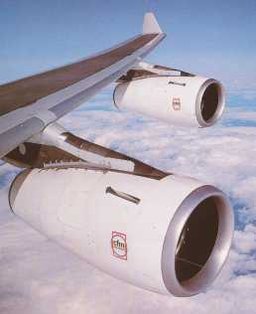CFM International CFM56
|
|
Cfm56-3-turbofan.jpeg
CFM International CFM-56 series engines is a family of high-bypass turbofan engines made by CFM International and has a thrust range from 18,500 to 34,000 lbf (82 kN to 151 kN). CFM International is a 50-50 joint company of Snecma Moteurs, France and General Electric Aircraft Engines, U.S.A. Both companies are responsible for producing various components, with each having their own final assembly line. GE is responsible for the high pressure turbojet, while Snecma is responsible for the low pressure front fans, the gearbox and the exhaust.
| Contents |
Variants
The CFM56 powers short-, medium- and long-range aircraft. Its core turbomachinery is based on the General Electric F101 engine developed for the B-1 Lancer bomber. It entered service in 1982 and there are now 13,000 CFM56 engines of all types in service.
CFM56-2 series
This is the earliest of the series with a thrust range of between 22,000 to 24,000 lbf (98 kN to 108 kN). It first appeared in the re-engined Douglas DC-8 Super 70 in 1982. Its success led to it re-engining military variants of Boeing 707. F108 is the engine's U.S. military designation. Today, the U.S. Air Force is CFM's largest customer, with more than 450 re-engined aircraft in service, or 1,800 CFM56-2 engines. This does not include later CFM56 variants on USAF and U.S. Navy 737 airframes.
CFM56-3 series
The first derivative of the CFM56 series, the CFM56-3 is designed for Boeing 737-300/-400/-500 series aircraft and is available with thrust ranging from 18,500 to 23, 500 lbf (82 kN to 105 kN). The slightly flattened nacelle bottoms are a distinctive feature of the Boeing 737 with CFM56 engines. It was first certified by the FAA in January 1984.
It is the most numerous turbofan variant in aviation history with 3,975 engines produced for the 737-300/-400/-500. It is very reliable and has a high resale value.
CFM56-5 series
The CFM56-5 series is designed for the Airbus aircraft. It has a very wide thrust rating of between 22,000 to 34,000 lbf (98 kN to 151 kN). It differs from its Boeing fitted cousins by features such as FADEC, advanced internal design giving improved performance over the CFM56-3 whilst maintaining the CFM56-3 reliability. It has 3 distinct sub-variants, the CFM56-3A, CFM56-3B and CFM56-3C. Both the CFM56-5A and CFM56-5B are ETOPS rated. The CFM56-5C is not due to its application in the 4-engined Airbus A340.
CFM56-5A series
CFM56-5A series is designed to power the short-to-medium range Airbus A320, with thrusts between 22,000 to 26,500 lbf (98 kN to 118 kN). This is the initial CFM56-5 series. Its design is derived from the CFM56-2 and CFM56-3 families.
CFM56-5B series
An improvement of the CFM56-5A series, it was originally designed to power the A321. Today, it powers every model in the A320 family (A318/A319/A320/A321), and has superseded the CFM56-5A series. Among the change over the CFM56-5A is the double annular combustor technology which reduces oxides of nitrogen emission by as much as 45 percent. It is also the most numerous engine supplied to Airbus. The thrust range is between 22,000 to 33,000 lbf (98 kN to 147 kN).
CFM56-5C series
With thrust rating of between 31,200 to 34,000 lbf (139 kN to 151 kN), CFM56-5C series is the most powerful of the CFM56 family. It powers the long-range Airbus A340-200 and A340-300 airliner and entered service in 1993.
For the A340, CFM International supplies the CFM56-5C series as a total propulsion system: engine, nacelle, and exhaust systems as opposed to just bare engines of the other variants.
It features exhaust design featuring mixer and an integrated nozzle for good efficiency (this design is also found in IAE V2500 series and on some Rolls-Royce RB211 series) and it also features the unique 'petal' thrust reversers rather than the conventional cascade design. This is due to the A340 requirements of maximum range and efficiency.
CFM56-7 series
The CFM56-7 powers the Next-Generation 737(Boeing 737-600/-700/-800/-900). The CFM56-7 is rated with takeoff thrust from 18,500 to 27,300 lbf (82 kN to 121 kN).
It has higher thrusts, improved efficiency, and lower maintenance costs than its predecessor, the CFM56-3 series. It incorporates many features from the CFM56-5 series such as FADEC, double annular combustor and improved internal design.
The CFM56-7-powered 737 is granted 180-minute Extended-Range, Twin-Engine Operations (ETOPS) approval by the U.S. Federal Aviation Administration. It also powers the military versions of the Next-Generation 737, the C-40 Clipper, Multimission Maritime Aircraft, and Project Wedgetail.
|
Lists of Aircraft | Aircraft manufacturers | Aircraft engines | Aircraft engine manufacturers Airports | Airlines | Air forces | Aircraft weapons | Missiles | Timeline of aviation |

